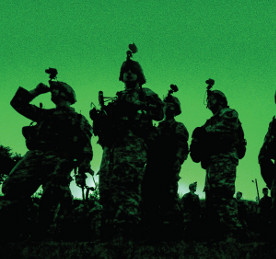
The nightsight can turn night into day for a soldier, which means that darkness no longer provides cover for enemy troops. With a nightsight their movements can easily be detected, exposing them to accurate fire.
A nightsight looks like an oversized telescopic sight. It enables a soldier to see clearly on all but the darkest nights by amplifying moonlight or starlight. First a highly sensitive photoelectric cell converts the image into an electrical signal, just as it would in a TV camera. Then the electrical signal is amplified by circuits similar to those of a hi-fi amplifier. It is finally turned back into an image and displayed on a small TV screen.
Even on a night that most people would describe as pitch black, there is usually some light, if only from the stars. In such conditions a soldier can accurately aim at a target up to 400yds (365m) away. More powerful versions, with a range of 1100yds (1km), are used by artillery, tanks, helicopters and aircraft.
If there is not even a glimmer of starlight, a different instrument can be used – an infrared camera, which detects hear rather than light. Objects that generate heat – for example aircraft, missile outlets, or army camp fires – can be detected at a range of several miles. These signals are used routinely in surveillance operations. During the Falklands War, they were used by British troops to detect the position of Argentine defences. Infrared cameras can also detect the body heat of an enemy soldier.
When all soldiers, tabks an aircraft are regularly equipped with nightsights, battle will be possible 24 hours a day.
Picture Credit : Google



